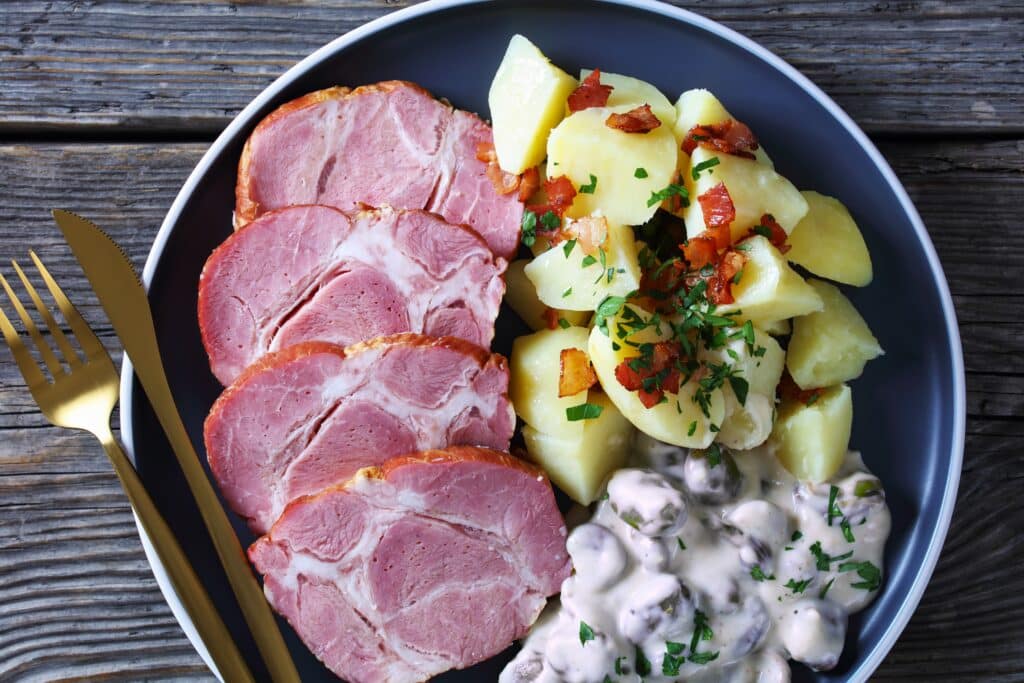Judd mat Gaardebounen, a hearty dish of smoked pork collar and broad beans, is the national dish of Luxembourg. Deeply rooted in the country’s history and culture, it offers a taste of tradition with every bite.
Our team at Remitly created this guide as part of our series that celebrates the traditional foods of our global customers.
The Origins of Luxembourg’s National Dish

The origins of Judd mat Gaardebounen are as rich as the dish itself. It hails from an era when preserving food was essential for survival.
Smoking was a popular method to preserve meat, leading to the creation of Judd—a smoked pork collar that forms the base of this dish.
Broad beans, or Gaardebounen in Luxembourgish, were often grown in home gardens. They were easy to cultivate and provided a nutritious addition to meals.
Combining these two ingredients resulted in a simple yet satisfying meal that could be enjoyed throughout the year.
Ingredients and Preparation
Preparing Judd mat Gaardebounen requires patience and precision. The smoked pork collar is soaked overnight to reduce its saltiness. It’s then simmered until tender—a process that can take several hours but ensures the meat absorbs all flavors.
The broad beans are cooked separately with onions, garlic, cream, and savory herbs until they reach a creamy consistency. Once both components are ready, they’re served together.
Recipe for Judd mat Gaardebounen
Ingredients
- 1 kg smoked pork collar
- 500 g broad beans
- 2 onions, finely chopped
- 2 cloves garlic, minced
- 200 ml cream
- A handful of savory herbs (thyme, rosemary)
- Salt and pepper to taste
- Boiled potatoes for serving
Preparation
- Soak the smoked pork collar in water overnight to reduce its saltiness.
- The next day, rinse the meat and place it in a large pot. Cover with water and bring to a boil.
- Reduce heat and let it simmer until tender—this can take several hours.
- While the meat is cooking, prepare the beans. Cook them in boiling water until soft.
- In another pan, sauté onions and garlic until golden brown.
- Add cooked beans to the onion mixture along with cream and herbs.
- Simmer until you achieve a creamy consistency.
- Season with salt and pepper according to your preference.
- Once both components are ready, serve them together with boiled potatoes on the side.
Remember: patience is key when preparing this dish—it’s all about slow cooking that allows flavors to develop fully.
Variations of Judd mat Gaardebounen
While Judd mat Gaardebounen remains consistent at its core—smoked pork collar and broad beans—regional variations do exist. Some regions prefer their beans less creamy while others add local herbs for an extra flavor kick.
In some parts of Luxembourg, you might find versions where bacon or sausage is added for additional depth.
Serving Suggestions
Traditionally, Judd mat Gaardebounen is served with boiled potatoes. A glass of local white wine or beer often complements the meal, enhancing its hearty characteristics.
While it’s typically enjoyed as a main course, smaller portions can be served as an appetizer.
Similar Dishes from Other Countries
Judd mat Gaardebounen shares similarities with other European dishes. Germany’s Eisbein (pickled ham hock) also uses pork as its main ingredient, but differs in preparation and flavor profile.
France’s Cassoulet, a slow-cooked casserole containing meat and white beans, bears some resemblance as well. Despite these similarities, Judd mat Gaardebounen stands out with its simplicity and distinct smoky flavor.
Luxembourgish Cuisine: A Blend of Influences
Luxembourgish cuisine reflects its geographical location—nestled between Germany, France, and Belgium—and Luxembourg’s history as an agricultural nation.
Farm-to-table
Traditionally reliant on farming, Luxembourg has a strong farm-to-table tradition that continues today—with dishes often featuring locally sourced ingredients like pork, potatoes, dairy products, and seasonal vegetables.
Influence from Neighboring Countries
The influence of neighboring countries is evident in many dishes. German-style sausages, French-inspired pastries, and Belgian beers are all integral parts of Luxembourgish cuisine.
Popular Dishes
Apart from Judd mat Gaardebounen, other popular dishes include Bouneschlupp (green bean soup), Gromperekichelcher (potato pancakes), and Quetschentaart (plum tart).
These dishes showcase the country’s love for hearty, comforting food that brings people together.
Visit the homepage, download our app, or check out our Help Center to get started.